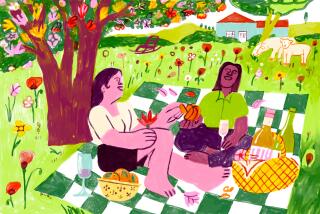France’s Ambitious Down-Under Languedoc, the oldest wine-growing region of the nation, is starting to produce sophisticated reds.
- Share via
“Bordeaux is tradition, and we are the future,” says Guido Jansegers, a distinguished-looking fiftysomething vintner, as we climb a mountain road in his car, passing massive limestone rocks, coarse and isolated patches of vineyard.
This is not a new wine region, though; it’s Corbieres, in the northwest of the Languedoc region in France, where the first vines were brought by the Romans.
Jansegers, a former insurance agent from Brussels, sold his home and business in 1993 to buy a run-down wine estate in Moux, Corbieres, called Cha^teau Mansenoble, despite never before having made wine. He has already gained a reputation for serious red wines.
He is not an isolated phenomenon, nor are his words about the future an exaggeration. In the last 10 years, a new generation of vintners, many originating from outside Languedoc, has revolutionized the once coarse, rustic reds of this region. Their goal is to make wines with the region’s traditional grape varietals but with an elegance reminiscent of top red Bordeaux.
Their commercial and critical success during recent years has spurred them on to greater things, and with their sophisticated reds of 1998, they open a new chapter in the wine history of the region.
“The 1998s are great because they are ripe and concentrated but also have wonderful balance,” Jansegers says. His 1998 Cha^teau Mansenoble “Reserve” has enveloping aromas of wild blackberry, with notes of cocoa powder and a hint of something animal. It is powerful and loaded with tannin but has a velvety texture and leaves a persistent sweet impression on the palate.
A blend based on the Syrah and Mourvedre grapes with some Grenache and Carignan, on paper it is a typical Corbieres, but in quality it is a world away.
“Half of it is aged in small new oak for aromatic complexity,” he explains, “and half in stainless steel to preserve the fruit.”
Some of the most exciting 1998 reds come from producers on the far eastern side of Languedoc in the Pic-St. Loup subregion of the Coteaux du Languedoc appellation.
Here there seems to be a direct relationship between the landscape and the wine style, the rule being that the bigger the mountains and the closer they stand to the vines, the more elegant the wine can be.
Situated directly between the jagged 2,000-foot peak of Pic-St. Loup and the 1,500-foot limestone wall of the Montagne d’Hortus, the Domaine de l’Hortus produces the ultimate “mountain wines” of Languedoc.
The wooden winery building that Jean Orliac of Domaine de l’Hortus put up in 1994 would not look out of place among a stand of redwoods in Mendocino County and, as it is with California’s leading winemakers, Orliac’s aim is to explore new possibilities.
His 1998 Bergerie de l’Hortus is packed with forest berry and spice flavors and has a freshness most unusual for a Mediterranean red wine.
What makes it even more remarkable is that the Syrah and Grenache that make 82% of this blend were vinified in stainless steel tanks; only the remaining 18% Mourvedre has been aged in old wood. These days few superior reds see so little oak during their aging.
Though Orliac’s red Grand Cuvee is matured exclusively in small oak, mostly new, the wood flavors are not overdone. The 1998 Grand Cuvee is a rich tapestry of fruit aromas ranging from red currant to black plum interwoven with a complex spice character. At once extravagant and sleek, it is a unique wine.
A short drive to the north of l’Hortus, boxed in by limestone cliffs on three sides, lies Cha^teau Lavabre. Owner-winemaker Olivier Briedel is also an immigrant. His previous business was extracting tannin from grape pips for industrial purposes.
A lanky figure with wild gray hair, wearing jeans with suspenders and a checked shirt, he looks as if he has been a winegrower his entire life, but his first vintage was 1995. It earned him lavish praise from critics around the world, and this rich and suave Syrah-based wine with a gentle hint of oak established his winemaking style.
“It is no problem to make massive, heavy wines here, and all you need to make a wine taste oaky is new barrels,” Briedel says as he draws a sample of the 1998 Chateau Lavabre from a tank. “But capturing the special aromas which the grapes can have is not easy.”
This wine has magnificently succeeded in doing so, brimming with smoke and spice character, rich and intense yet elegant and dry.
The way its aromas slowly expand as you swirl the wine in your glass calls to mind a classic Bordeaux such as Cha^teau Cheval Blanc from St.-Emilion. Though very different in flavor from Cheval Blanc, Briedel’s Chateau Lavabre also needs time to develop and has many years of aging potential.
My hunch is that if this wine and the other top 1998 Languedoc reds fulfill their promise, it will mean a breakthrough for the region. Then such growers as Briedel, Jansegers and Orliac will have proved that Languedoc is no longer just a source for modestly priced alternatives to Bordeaux but that it has classic wines of its own.
Wines from Domaine de l’Hortus are widely available, at stores including Mission Wines in South Pasadena, Wine Country in Long Beach, Hi-Time Wine Cellars in Costa Mesa, Epicurus in Santa Monica, Woodland Hills Wine Co., Bristol Farms and Renegade Wines in Santa Barbara. If you can’t find them, have your retailer call Michael Sullivan at Beaune Imports, (510) 841-9815.
Wines from Cha^teau Mansenoble and Cha^teau Lavabre are not yet available on the West Coast. Mansenoble is imported by Angeles Wine Agency, (818) 764-2221; Lavabre by European Wine Cellars, (212) 924-4949.
More to Read
Eat your way across L.A.
Get our weekly Tasting Notes newsletter for reviews, news and more.
You may occasionally receive promotional content from the Los Angeles Times.










